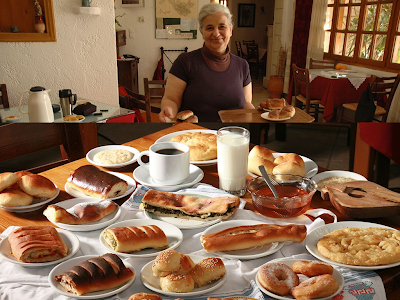- By Deepa Krishnan
Venues:
There's an exhibition currently going on at two art galleries, Max Mueller Bhavan and Mirchandani+Steinruecke. It's called "Touched by Bhupen", and it pays homage to the artist Bhupen Khakhar, who died in 2003. A group of 26 artists have come together to display art works and installations inspired by Khakhar.
 |
| Poster as soon as you enter Galerie Max Mueller |
So why all the fuss about Bhupen Khakhar, you ask? Who was he, anyway?
 |
| Photos of Bhupen Khakhar, sourced from http://bhupenkhakharcollection.com |
Bhupen Khakkar is considered to be one of most iconic, provocative and controversial artists of 20th century India. Born in Bombay in 1934, he moved to Baroda in the 60's. His paintings, with their street and daily life imagery, combined with some sardonic and playful twists, have been a major influence on Indian artists. He was among the earliest to portray the ordinary - the tailor, the rickshawalla, the barber - in ways that celebrated the mundane. He used historical and mythological references, as well as stylistic references to traditional painting techniques, to create a unique style of his own. Khakhar was the leading member of what is called the 'Baroda group', a set of artists who defined the art scene in the 70's. .
In the 80's Khakhar created a sensation by becoming India's first openly gay artist to express his homosexuality on canvas. In a repressed era where such subjects were taboo, this made him iconic.
 |
| "You can't please all", 1981, Bhupen Khakhar |
In "You can't please all", Bhupen Khakkar references the Aesop's fable of the boy and his father taking a donkey to the market. The man on the balcony overlooking this street scene is himself. He painted this at his house in Baroda, at a point in time where he had not yet openly declared himself gay.
My introduction to Bhupen Khakhar came in Bangalore this September, where I attended a talk at the NGMA. I learnt that it was only after the death of his mother that he could bring himself to come out. "I can't do this to her", he told a friend. "She won't understand."
But after she died, he began expressing himself through his work. Here is one that moved me, because you can see he is not afraid to express his insecurity and need:
 |
| "How many hands do I need to declare my love to you?" Watercolour, 1994 |
Since that talk at NGMA, I have looked up many of Bhupen Khakhar's works online, checked out photos and tidbits, trying to piece together who he was, and how this boy from a traditional Gujju family in Khetwadi could actually come out finally and declare his sexual orientation to the world. I've read what his friends have to say about him. What emerges from all the things written about him is that he was a unique man. Someone who was not afraid to paint his inner world, someone who appreciated the beauty within the mundane, who was not afraid of the grotesque. Above all, a man who was not afraid to declare his hurts and disappointments.
Anyway - I was quite intrigued by the concept of 26 artists doing tribute to Khakhar, and it so happened that I was passing by Max Mueller Bhavan, so I popped in to have a look:
 |
| Jogen Chowdhury's "His peaceful life in Heaven" on the left. I don't remember what the one on the right was called. |
 |
| Karmakar's "Door" and "35 Views", two installations referencing how Khakhar shows both the inner and outer worlds. And also referencing the voyeurism in Khakhar's art |
Of course, one of the problems with this kind of tribute/homage is that it tends to have all kinds of impossible-to-understand references, since each artist is influenced by Khakhar in different ways. But leaving that aside, there is some really good stuff to see. These 26 include some of the major contemporary artists in India today, so if you are anywhere near the Gateway of India, then you have until Jan 6th to check it out.
Like I said earlier, there are two venues; Max Mueller Bhavan and Mirchandani+Steinruecke.
I did not go to Mirchandani+Steinreucke, but I am very tempted to go, having seen all these interesting installations and exhibits on their website
 |
| Clockwise: Anju Dodiya, Sudhir Patwardhan and Gulammohammed Sheikh |
In case you are planning to go, here is some practical information:
Exhibition details:
Exhibition details:
Dates: Friday, 29th November 2013 to Monday, 6th January 2014
Venues:
1) Galerie Mirchandani + Steinruecke
(Tuesday – Saturday 11 am to 7 pm)
(Tuesday – Saturday 11 am to 7 pm)
2 Sunny House, 16/18 Mereweather Road, Behind Taj Mahal Hotel, Colaba, Mumbai 400 001
2) Galerie Max Mueller, Max Mueller Bhavan, next to Jehangir Art Gallery - +91 22 2202 3030/ 3434 - Call and check opening days and hours before you go. I think they are closed Mondays.




















































